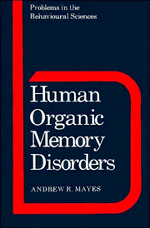Book contents
- Frontmatter
- Contents
- Acknowledgements
- 1 Healthy and pathological memory: the underlying mechanisms
- 2 The assessment of memory disorders
- 3 Disorders of short-term memory
- 4 Disorders of previously well-established memory
- 5 The memory problems caused by frontal lobe lesions
- 6 Organic amnesia
- 7 Animal and biochemical models of amnesia
- 8 Less well-characterized memory disorders
- 9 Overview
- Glossary
- Bibliography
- Index
7 - Animal and biochemical models of amnesia
Published online by Cambridge University Press: 01 June 2011
- Frontmatter
- Contents
- Acknowledgements
- 1 Healthy and pathological memory: the underlying mechanisms
- 2 The assessment of memory disorders
- 3 Disorders of short-term memory
- 4 Disorders of previously well-established memory
- 5 The memory problems caused by frontal lobe lesions
- 6 Organic amnesia
- 7 Animal and biochemical models of amnesia
- 8 Less well-characterized memory disorders
- 9 Overview
- Glossary
- Bibliography
- Index
Summary
It has proved difficult through the study of human amnesics to elucidate several matters critical to understanding the disorder. First, human cases are not usually appropriate for identifying the critical lesions that cause the core memory problems because their lesions often extend into brain regions where damage causes unrelated deficits. Second and relatedly, it is hard to determine from human amnesics the extent to which their memory deficits result from damage to neurons that release specific transmitters, such as acetylcholine or noradrenalin. Third, despite developments with electrophysiological recording techniques and the emergence of the PET scan, study of human amnesics and healthy people is not an effective means of exploring the anatomical connections and physiology of the brain regions lesioned in amnesics in order to gain a clearer idea of precisely what functions are disrupted in patients. These three issues have been more effectively examined through physiological studies with animals and pharmacological studies with animals and humans. The next section discusses animal models of the amnesic state. The third section briefly reviews what light pharmacological studies have thrown on amnesia, and the last section considers animal work involving lesions, electrophysiological recordings, and manipulations of long-term potentiation (LTP). As indicated in chapter 1, LTP is an increase in neural responsiveness, particularly striking in hippocampal neurons, that occurs when brief bursts of high-frequency stimulation are given to the inputs of the relevant neurons. It may persist for weeks and is believed by many to be based on a memory-like change. LTP is of interest here because it has been used to examine the functions of the structures whose damage is believed to be critical in amnesia.
- Type
- Chapter
- Information
- Human Organic Memory Disorders , pp. 195 - 239Publisher: Cambridge University PressPrint publication year: 1988



